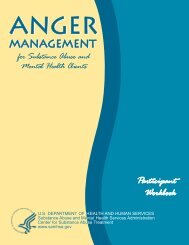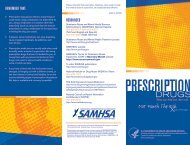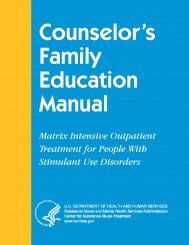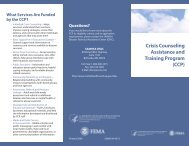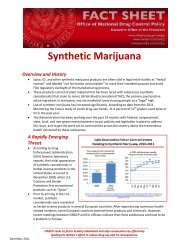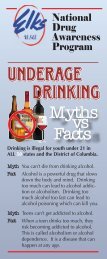Counselor's Manual for Relapse Prevention With Chemically ...
Counselor's Manual for Relapse Prevention With Chemically ...
Counselor's Manual for Relapse Prevention With Chemically ...
Create successful ePaper yourself
Turn your PDF publications into a flip-book with our unique Google optimized e-Paper software.
Exercise No. 17: Identifying High-Risk SituationsPurpose. This exercise helps the patient identify the kinds of high-risk situations that may triggerthe warning sign on the final warning sign list.Instructions. Ask the patient to review this exercise in group. Ask the group to question thepatient about what the high-risk situations have in common, whether they are on the list ofcritical high-risk situations, and whether the situations are related to things that happenedpreviously in the patient's life.Exercise No. 18: Identification of Core BeliefsPurpose. The purpose of this exercise is to help the patient identify the core or mistaken beliefsthat cause the high-risk situation to trigger the warning signs.Instructions. Have the patient summarize the worksheets in this exercise to the group. Then askthe patient to read aloud the sentence completion portion of the exercise (No. 3). Ask the groupmembers to report any other core beliefs that the patient did not identify.Exercise No. 19: Combined Mistaken Belief ListPurpose. This exercise helps the patients break down mistaken beliefs into specific mandates andinjunctions that come up in their lives.Instructions. Ask the patient to write his or her core beliefs, along with the mandate andinjunction lists, on the blackboard. Ask the group to give the patient feedback about anymandates or injunctions that they see in the core belief list that are not already identified, andhave the patient add them to the list.Exercise No. 20: Challenging Mandates and InjunctionsPurpose. This exercise helps the patient to identify mandates and injunctions that they are usingthat are not true.Instructions. Ask the patient to read the list of mandates and injunctions one at a time to thegroup. For each item, ask the patient's opinion as to why it is or is not true. Have the group givethe patient feedback on why they believe the item is or is not true and if it is false, what is trueinstead.Exercise No. 21: Challenging MandatesPurpose. This exercise allows the patient to take the in<strong>for</strong>mation about mandates obtained fromthe group and identify different ways to handle the mandates in the future.Instructions. The patient should read the mandate, realize other ways that he or she can thinkinstead, and state what he or she thinks the possible outcomes of thinking in these ways would



